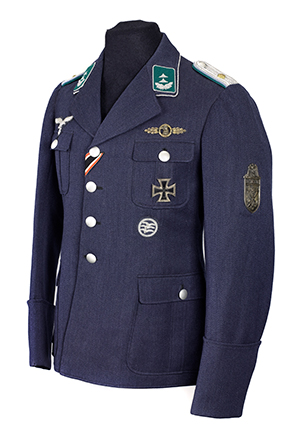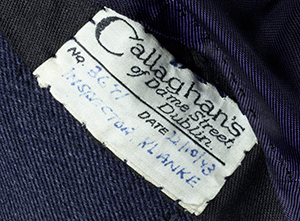Arthur Klanke’s (Irish-made) Luftwaffe uniform
Published in Artefacts, Issue 1 (January/February 2021), Volume 29By Pat McCarthy

Above: Arthur Klanke’s Luftwaffe uniform, which, as the label (inset) shows, was made by ‘Callaghan’s of Dame Street, Dublin’. (NMI)
Given the number of German airmen interned in Ireland during the Emergency, a Luftwaffe uniform in the National Museum’s collection is not unexpected. What is unusual about this one, however, is that it was made in Ireland. Even more unusual is the story of its owner, Arthur Klanke.
He was born in Solingen on 11 July 1912. After completing his university education he joined the German meteorological service, but within a few years his career path changed completely. The outbreak of war in September 1939 meant that weather data became military secrets—accurate forecasting was vital to the German war effort. Weather reports, which had been freely shared between countries in peacetime, became restricted data.
The solution was the collection of the data by specially equipped aircraft—the meteorological squadrons or Wekusta. Trained civilian meteorologists like Klanke were drafted into the Luftwaffe. Among Klanke’s first missions was a weather reconnaissance flight over Narvik, Norway, on 3 June 1940. Bad weather and instrument failure forced the plane to land in neutral Sweden, where the crew were interned. Sweden had the same sort of lenient policy towards German aircraft as Ireland had towards Allied aircraft; after a month in an internment camp, the crew were quietly repatriated.
 On returning to Germany Klanke was assigned to Wekusta 2, based near Paris. From there a Junkers 88, with Klanke on board, took off in the early hours of 26 December 1941. Off the west coast of Ireland, problems with the oil pumps forced the pilot to head for the nearest land. Just after one o’clock that afternoon the aircraft crossed the Irish coast and crash-landed in a bog near Mastergeehy, five miles north of Waterville, Co. Kerry. The crew of four survived. They were arrested and taken first to Tralee military barracks and from there to the Curragh. Klanke, who spoke fluent English, told the interrogating officer that, having escaped from internment in Sweden after five weeks, he expected to do the same from Ireland. It was not to be, and he spent the rest of the war as a guest of the Irish state. In October 1943 he had Callaghan’s of Dame Street, Dublin, make him a new uniform.
On returning to Germany Klanke was assigned to Wekusta 2, based near Paris. From there a Junkers 88, with Klanke on board, took off in the early hours of 26 December 1941. Off the west coast of Ireland, problems with the oil pumps forced the pilot to head for the nearest land. Just after one o’clock that afternoon the aircraft crossed the Irish coast and crash-landed in a bog near Mastergeehy, five miles north of Waterville, Co. Kerry. The crew of four survived. They were arrested and taken first to Tralee military barracks and from there to the Curragh. Klanke, who spoke fluent English, told the interrogating officer that, having escaped from internment in Sweden after five weeks, he expected to do the same from Ireland. It was not to be, and he spent the rest of the war as a guest of the Irish state. In October 1943 he had Callaghan’s of Dame Street, Dublin, make him a new uniform.
In August 1945 the German internees were repatriated to Germany, with the exception of four (including Klanke, who was in hospital with TB) who were allowed to stay in Ireland on compassionate grounds. Two years later, on 20 June 1947, Klanke married Heimlinde Dietrich, an Austrian laboratory technician who was working in a Dublin hospital.
The previous August, 1946, a 40ft Swedish-registered yacht, the Svea, had sailed up the Suir estuary and moored at Waterford docks. The owner, Siegfried Vogler, had been a prisoner of war of the Allies in Germany before escaping to Sweden, from where he sailed the Svea to Waterford. There Vogler waited for his wife to join him. She finally arrived in July 1947. The yacht then left Waterford with two extra passengers on board—Arthur and Heimlinde Kranke. After a voyage of five months, the boat reached Venezuela. Arthur got a job in the University of Caracas and as Professor Arturo Kranke contributed to scientific journals on meteorological matters. He died of cancer on 3 July 1977. Heimlinde then returned to Germany and died in 2009.
Pat McCarthy is a member of the Military History Society of Ireland and a Research Associate of the Department of History and Geography, DCU.
















